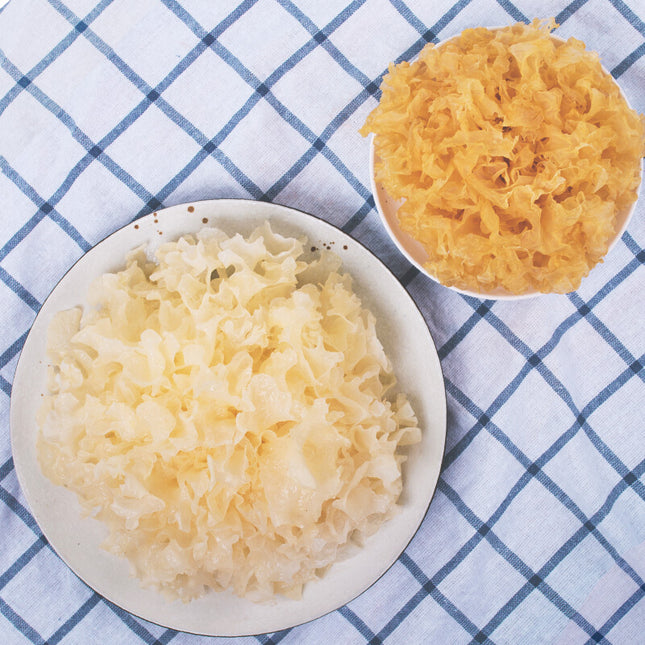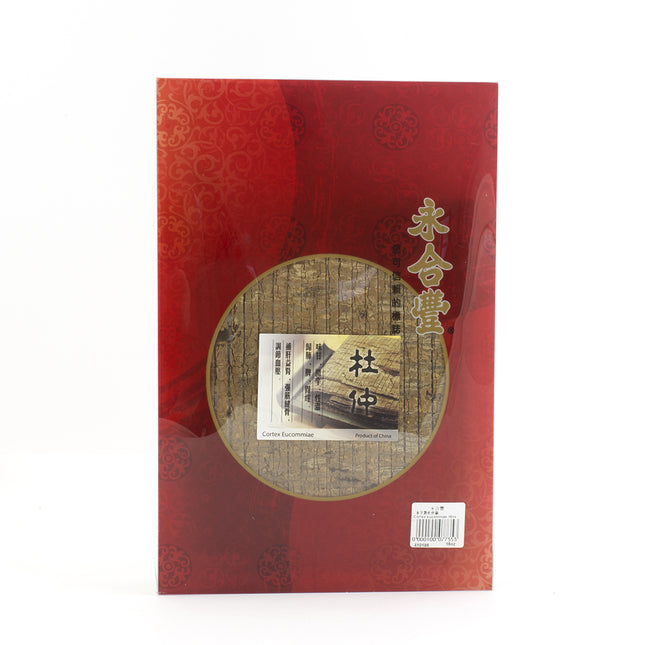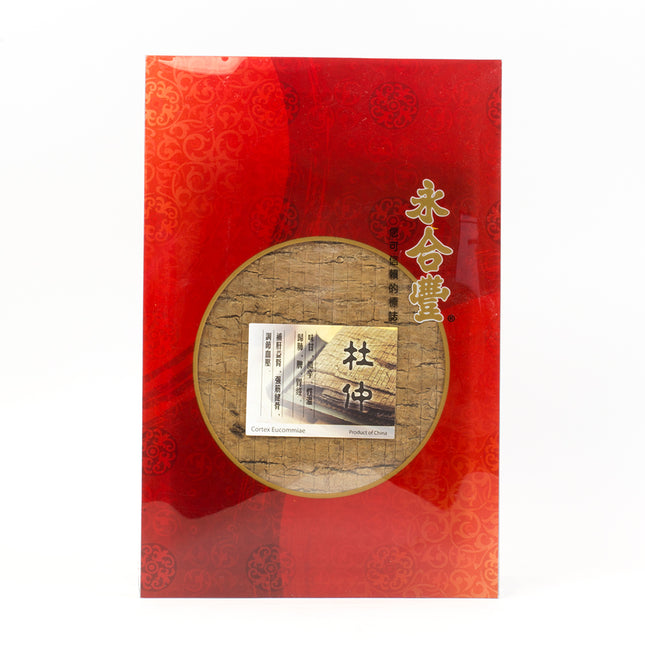產品


雪耳/银耳(5 oz/包)
雪耳/银耳/白木耳(5 oz/包) 明清之际,天然品相好的银耳一直是皇帝和达官显贵养生益寿的佳品,如清代女官德龄所著《御香飘渺录》中所说:“银耳那样的东西,它的市价贵极了,往往一小匣子银耳就要花一二十两银子才能买到。 优质银耳应为白色或浅米黄色,朵基部呈现黄色、黄褐色,朵形完整。表面无霉变、无虫蛀、有光泽、没有杂质。银耳并不是越白越好,很白的银耳一般是使用硫磺熏蒸过的,所以选银耳应选白中略带黄色的。 性味 甘;淡;平 经脉 肺经;胃经;肾经 功效 补肺益气,养阴润燥。用于病后体虚,肺虚久咳,痰中带血,崩漏,大便秘结,高血压病,血管硬化。 注意禁忌 风寒咳嗽者及湿热酿痰致咳者禁用。 食疗方 银耳羹 银耳5克,浸泡发开后,放入碗中,加少量水,隔水蒸一个小时,再加适量冰糖,继续蒸至稠羹状,一次吃完。每晚睡前服用。 双耳听琴 原料:木耳,银耳,芹菜。将木耳、银耳用温水泡开淘净,摘去蒂,嫩芹菜摘叶洗净,切成段。木耳、银耳撕碎。木耳、银耳、芹菜分别用开水烫过,用精盐、味精、料酒、香 油调好口味,装盘即成。 功效:滋阴,润肺,生津,凉血,清脑,降血压。 People started cultivating these beautiful mushrooms (a type of fungi) in China in 1894 during the Qing Dynasty but they were collected in the wild as far back as 200 A.D. Tremella (AKA white fungus, snow fungus) has been used for centuries for its beauty-enhancing benefits. Like other mushrooms, tremella is loaded with vitamin D, high in antioxidants and anti-inflammatory. Many of tremella’s health benefits are due to its high amounts of polysaccharides which are antioxidants that can help keep our complexion hydrated and healthy. High amounts of vitamin D in tremella play a role in helping skin cell growth and both repairing and preventing premature skin aging. Vitamin D is also a fat-soluble vitamin, which means it plays a role in keeping skin hydrated and supple. In addition to helping keep skin looking smooth and glowing, tremella has a lot of other health benefits, such as helping to boost the immune system and lower inflammation. Polysaccharides in tremella can help maintain skin integrity and avoid sagging skin, as well as weak bones, and joint stiffness. Tremella’s powerful anti-inflammatory benefits have greater implications for their ability to fight off diseases like heart disease, high cholesterol, and tumors and other health problems caused by inflammation, including acne, respiratory illness, and headache. According to TCM, traditional Chinese medicine, tremella is sweet and light and enters the Meridians of the Lung Channel; Stomach Channel; Kidney Channel. TCM Indications: Nourishes yin and moistens dryness. It is useful for recovery from illness or surgery resulting in physical weakness, also for chronic cough, bloody sputum, uterine bleeding, constipation, hypertension, and arteriosclerosis. Precautions: people with mushroom allergies should use caution. People with chronic cough with sputum that is either clear and watery (internal cold) or thick and yellow (damp heat) should avoid use and address the underlying imbalance. How to cook tremella: Sweet Tremella Soup Tremella has a rather mild, slightly sweet taste. They are especially used in Southeast Asian soups and desserts, though their mild taste makes them good for a variety of dishes. Cooking tremella releases its collagen into the soup. Soak one piece of tremella in water overnight so that it becomes softer, Rinse it carefully. With a knife or scissor remove the darker yellow tough center from the back of the tremella. In a cooking pot of cold water to cover the tremella, bring the water to boil then simmer for 45 minutes. Add a handful of Jujube red dates and simmer for another 20 minutes. Add 1 tablespoon of dried goji berries and simmer for 2 minutes. Serve the dessert soup in a bowl and when cool add raw honey to taste.
$7.68

龍牙百合(8 oz)
龙牙百合(8oz) 性味 甘;微苦;微寒 功效 本品为百合科植物卷丹、百合或细叶百合的干燥肉质鳞叶。 主治肺燥或阴虚久嗽,咳唾痰血;热病后余热来清,虚烦惊悸,神志恍惚;脚气浮肿。 经脉 心经;肺经 主治 养阴润肺,止咳,清心安神。治肺燥或阴虚久嗽,咳唾痰血;热病后余热来清,虚烦惊悸,神志恍惚;脚气浮肿。 (1)润肺止咳:用于肺燥或阴虚之咳嗽、咯血,常配川贝。 (2)清心安神:用于热性病后余热不清、虚烦不眠、神志恍惚,常配地黄。 用法用量 内服:煎汤,6~12g;或入丸、散;亦可蒸食、煮粥。 外用:适量,捣敷。 注意禁忌 风寒咳嗽及中寒便溏者忌服。 Dry Lily Bulb/ Long Ya Bai He (8 oz) Pleasant tasting, sweet; slightly bitter; Its actions are slightly cooling. This product is called dried succulent lily bulb, leaves of lily plant, lily of the valley, or lily. It treats lung dryness or chronic “yin deficiency,” coughing, spitting bloody phlegm, following fever with residual inflammation, anxiety, palpitations, dizziness and edema. It enters the Heart and Lung Channels. Indications Nourishes Yin (enhances fluids and tissue in lung, stomach and kidney,) nourishes the lungs, relieves cough, and calms the mind. It improves chronic lung dryness. Major herbal combinations: (1) For cough and hemoptysis (bloody nose) from lung dryness or yin deficiency, it is often used with Chuan Bei Mu (Tendrilled Fritillaria Bulb) (2) For Clearing the mind and calming the nerves, “turbid heat” mental confusion after fever, insomnia, mental confusion it is often used with Rehmannia glutinosa. Dosage: Oral: Jiantang, 6~12g; or pill and powder; steamed or porridge. Topical: Appropriate amount, apply. Cautions: People with cough and cold and diarrhea should not take it.
$10.99

生地片 幹地黃 6oz
生地片/干地黃(6 oz/包) Drying Rehmannia Root 干地黄、原生地、干生地 性味 味甘;苦;微寒 功效 为玄参科植物地黄的块根。用于热病烦渴,内热消渴,骨蒸劳热,温病发斑,血热所致的吐血,崩漏,尿血,便血,血虚萎黄,眩晕心悸,血少经闭。 经脉 归心经;肝经;肾经 主治 滋阴清热,凉血补血。主热病烦渴,内热消渴,骨蒸劳热,温病发斑,血热所致的吐血,崩漏,尿血,便血,血虚萎黄,眩晕心悸,血少经闭。 用法用量 内服:煎汤,10~15g,大剂量可用至30g;赤可熬膏或入丸、散;或浸润后捣绞汁饮。 外用:适量,捣敷。 注意禁忌 脾虚泄泻、胃虚食少、胸膈多痰者慎服。 【食疗方】 1.三味地黄酒 生地黄(切)100克,大豆(炒)200克,牛蒡根(切)100克,酒2升。将药用白纱布袋盛之,置于净器中,入酒浸泡,密封,5日后开启,过滤后装瓶备用。不拘时,随量饮之。每日1~2次,每次饮服1~2小盅。 功效:补肾除烦,祛风止痛。适应症肾虚,心烦,关节疼痛。 2.桃仁粥 桃仁、生地各10克。桃仁浸泡后,去皮弃尖,加入适量冷水,武火煮沸,改文火慢煎。30分钟后,除去药渣,将洗净的粳米洗净加入药汁中煮粥。粥熟加入桂心粉(药店有售)2克,红糖50克。每次食1小碗,每天3至4次。 功效:活血止痛、滋养脾胃;适用于消化性溃疡出血停止后或无发生出血者。** 3.百部炖团鱼 百部20克,生地20克,地骨皮12克,知母10克,团鱼(甲鱼)1只,葱姜佐料各适量。将团鱼头宰下,放血,入沸水锅中略氽,当裙边与甲壳分离时捞出,去粗皮与内脏,宰成块,中药放纱布袋内封口,锅置旺火上,加清水,下垫鸡骨,加入团鱼,烧开后撇去血沫,加中药包、姜、葱、绍酒,移至小火上炖至熟软,除去鸡骨、葱、姜,加入精盐、味精调味即成。 功效:滋阴清热,润肺止咳。主治肺结核,肺虚咯血,阴虚潮热盗汗等症。 4.海带生地绿豆瘦肉汤 取海带30克,生地18克,绿豆100克,陈皮3克,瘦猪肉100克。将海带洗净泡发切丝,猪肉、陈皮洗净切丝,与生地、绿豆同置砂锅内,加水适量用小火煲2小时,加食盐少许即可食用。服法:煮粥服用。 功效:此药膳具有清热解毒、凉血养阴之功效,常服可治疗粉刺反复发作。 5.人参地黄粥 人参10克,栗米100克,生地黄30克,冰糖适量。水煎人参、生地、去渣留汁,入栗米煮粥。将熟加冰糖适量,稍煎待溶即成。酌情服食,温凉为宜。 功效:益气养阴。 6.琼玉膏 人参120克,生地黄汁800克,白茯苓245克,蜂蜜500克。将人参、茯苓粉碎成细末,生地黄捣取自然汁(捣时不用铜铁器),用绢过滤蜜,将四物合并搅匀,装入瓷罐内,用20~30层净纸封闭。取大铝锅一口,盛装净水,将药罐放入铝锅内,先用武火,后用文火,隔水煮熬,三天三 夜后取出,用蜡封罐口,入水中浸去火毒10日,再入原锅内煮一天一夜即成。 服法:早晚各服1次,空腹服,每次1汤匙。 功效:补气养血,填精生髓。主治作为中老年人平时的保健食品。 出自:https://zhongyibaike.com/ Drying Rehmannia Root /Sheng Di Pian(6 oz/Bag) Rehmannia root clears heat, cools blood, nourishes yin, and promotes body fluids production. Rehmannia root is often used in conditions like fever, fluid exhaustion, consumptive diseases, bleedings, anemia, dizziness, palpitations, and menstrual disorders... Rehmannia root contains sterol, glycosides, and polysaccharides, its active components are mainly iridoid glycosides, such as catalpol, rehmanniosides A-D, leonuride, aucubin, melittoside, jioglutoside A-B, 6-O-E-feruloyl ajugol, rehmaglutins A-D, glutinoside, purpureaside C, echinacoside, jionosides A1 & B1, cistanosides A & F, and acteoside. Its polysaccharides include stachyose, raffinose, glucose, sucrose, fructose, manninotriose, galactose and rehmannia glutinosa polysaccharides (RPS-b). Rehmannia root also contains over 20 kinds of amino acids, as well as alkaloids, phosphoric acid, organic acids, adenosine, trace elements, lecithin and vitamin A. The actions of Rehmannia root include regulating blood sugar, blood pressure, and immune functions. It can also affect the pituitary-adrenal and thyroid secretions, as well as anti-inflammation, cooling body, diuresis, anti-tumor, anti-aging, liver protection, promoting blood clotting, stimulating blood cells growth and gland secretions http://www.shen-nong.com/eng/herbal/dihuang.html From the manufacturer: The taste is sweet, bitter; and it is slightly cold in effect. It is the root tuber of Scrophulariaceae plant Rehmannia glutinosa. It is used for fever polydipsia, internal heat, it is used to reduce thirst, bone steaming [inflammatory aarthritis] and fatigue, febrile plaque, hematemesis, uterine bleeding, blood in urine, blood in stool caused by blood heat, blood deficiency, and chlorosis, dizziness, palpitations, blood loss, and amenorrhea. It enters the Liver and Kidney meridians. Indications: It nourishes yin and clears away heat, cools, and nourishes the blood. Dosage: Oral administration: decoction, 10~15g, large doses can be used up to 30g; It can be used to make an ointment or pills or powder, or pounded juice after infiltration. External use: appropriate amount, pound and apply. Cautions: Use caution with patients who have spleen deficiency, diarrhea, stomach deficiency, loss of appetite, and excessive sputum in the chest, stomach, and lungs.
$6.99

原個大生地 L(16 oz/包)
原个大生地 生地黃 L(16 oz/包) 性味 味甘;苦;微寒 功效 为玄参科植物地黄的块根。用于热病烦渴,内热消渴,骨蒸劳热,温病发斑,血热所致的吐血,崩漏,尿血,便血,血虚萎黄,眩晕心悸,血少经闭。 经脉 归心经;肝经;肾经 主治 滋阴清热,凉血补血。主热病烦渴,内热消渴,骨蒸劳热,温病发斑,血热所致的吐血,崩漏,尿血,便血,血虚萎黄,眩晕心悸,血少经闭。 用法用量 内服:煎汤,10~15g,大剂量可用至30g;赤可熬膏或入丸、散;或浸润后捣绞汁饮。 外用:适量,捣敷。 注意禁忌 脾虚泄泻、胃虚食少、胸膈多痰者慎服。 Drying Rehmannia Root /Sheng Di (16 oz/Bag) Rehmannia is commonly found in herbal combinations used in Traditional Chinese Medicine. Rehmannia is used for diabetes, metabolic syndrome, obesity, kidney disease, chronic obstructive pulmonary disease (COPD), "tired blood" (anemia), fever, weakened bones (osteoporosis), rheumatoid arthritis (RA), and allergies. (webMD.com) This is raw, unprocessed rehmannia, sheng di huang, is energetically cold, sweet, and bitter. It works in the heart, kidney, and liver channels. ... It also works in the heart, kidney, and liver channels, and is said to tonify the blood and nourish the yin. . .There are two preparations: raw rehmannia, called Sheng Di Huang, and prepared rehmannia, called Shu Di Huang. Both raw and prepared rehmannia nourish yin and blood; however, the raw sheng di huang is used more to dissipate heat, allowing the body to generate more fluids, while the prepared shu di huang is used more to nourish the body when deficiencies of yin qualities of cool and moist result in too much heat or dryness in the system. https://ndnr.com/botanical-medicine/an-herb-for-our-yin-deficient-world/ The taste is sweet, bitter and it is slightly cold in effect [anti-inflammatory] It is the root tuber of Scrophulariaceae plant Rehmannia glutinosa. It is used for fever polydipsia, internal heat diminishment, bone steaming and labor [inflammatory and rheumatoid arthritis], febrile disease spots [rash], hematemesis, uterine bleeding, hematuria, blood in the stool caused by blood heat, blood deficiency and chlorosis, dizziness, palpitations, blood loss and amenorrhea. It enters Guixin [Lu 9 acupuncture pt], Liver and Kidney meridians. Indications: Nourishes yin and clears away heat, cools and nourishes blood. Dosage: Oral administration: decoction, 10~15g, large doses can be up to 30g; Or can boil ointment or pill or powder, or mash and drink after infiltration. External use: appropriate amount, pound and apply. Cautions: Patients with spleen deficiency and diarrhea, stomach deficiency, poor appetite, and thoracic and diaphragmatic sputum should use caution.
$19.99

麦冬(8oz)
麦冬粒(8oz/包) 性味 甘,微苦,微寒。 经脉 归心经、肺经、胃经。 主治 养阴润肺,清心除烦,益胃生津。治肺燥干咳,吐血,咯血,肺痿,肺痈,虚劳烦热,消渴,热病津伤,咽干口燥,便秘。 注意禁忌 凡脾胃虚寒泄泻,胃有痰饮湿浊及暴感风寒咳嗽者均忌服。 ①《本草经集注》:地黄、车前为之使。恶款冬、苦瓠。畏苦参、青囊。 ②《药性论》:恶苦芺。畏木耳。 ③《纲目》:气弱胃寒者必不可饵。 Dwarf Lilyturf Tuber/Radix Ophiopogonis / Mai Dong (8oz/pack) Ophiopogonis is an herb known in traditional Chinese medicine for its ability to treat a yin deficiency, which means it is used to clear heat, dryness, and irritability. ... It is used to treat insomnia, anxiety, palpitations, and it is used to lower the blood pressure. From the manufacturer: The taste is sweet, slightly bitter, and it is slightly cold. It enter the Guixin, Lung, and Stomach meridians. Indications: Nourish yins (fluids) and lungs, clears heart and remove troubles [helps regulate heart action], benefits stomach and promotes fluid. It has been used to cure dry cough, vomiting blood, hemoptysis, pulmonary dysfunction, pulmonary carbuncle, fatigue and irritation; it reduces thirst, fever and body injury, dry throat, dry mouth, and constipation. Cautions: It should be avoided by those who suffer from diarrhea due to cold in the spleen and stomach, phlegm, dampness and turbidity in the stomach, and violent wind-cold cough. Avoid its use for patients with congested fluids.
$15.50


特選 四川厚杜仲 (16 oz)
特選 四川厚杜仲(16 oz/盒) 性味 甘;微辛;性温 功效 为杜仲科植物杜仲的干燥树皮。 主治腰脊酸疼,足膝痿弱,小便余沥,阴下湿痒,胎漏欲堕,胎动不安,高血压。 经脉 肝经;肾经 主治 补肝肾,强筋骨,安胎。治腰脊酸疼,足膝痿弱,小便余沥,阴下湿痒,胎漏欲堕,胎动不安,高血压。 ①《本经》:主腰脊痛,补中益精气,坚筋骨,强志,除阴下痒湿,小便余沥。 ②《别录》:主脚中酸痛,不欲践地。 ③《药性论》:治肾冷臀腰痛,腰病人虚而身强直,风也。腰不利加而用之。 ④《日华子本草》:治肾劳,腰脊挛。入药炙用。 ⑤王好古:润肝燥,补肝经风虚。 ⑥《本草正》:止小水梦遗,暖子宫,安胎气。 ⑦《玉楸药解》:益肝肾,养筋骨,去关节湿淫。治腰膝酸痛,腿足拘挛。 ⑧《本草再新》:充筋力,强阳道。 用法用量 内服:煎汤,6~15g;或浸酒;或入丸、散。 注意禁忌 1.阴虚火旺者慎服。 2.《本草经集注》:恶蛇皮、元参。 3.《本草经疏》:肾虚火炽者不宜用。即用当与黄柏、知母同入。 4.《得配本草》:内热、精血燥二者禁用。 Eucommia Bark/ Sichuan Du Zhong (16 oz/Box) Eucommia ulmoides (EU) (also known as “Du Zhong” in Chinese language) is a plant containing various kinds of chemical constituents such as lignans, iridoids, phenolics, steroids, flavonoids, and other compounds. These constituents of EU possess various medicinal properties and have been used in Chinese Traditional Medicine (TCM) as a folk drink and functional food for several thousand years. . . The health-promoting properties of EU on cardiovascular system and antioxidant, antibacterial, antiviral, anti-inflammatory, anti-obesity, and neuroprotective effects and metabolic modulation on bones and phytoestrogenic properties have attracted much interest in the extraction and functional development of active ingredients of EU. Evidenced based complementary and alternative medicine. https://www.ncbi.nlm.nih.gov/pmc/articles/PMC4793136/ From the manufacturer: The taste is sweet, slightly pungent; and it is warming in nature. It is the dry bark of Eucommia ulmoides. Indications are for lumbar spine pain, weak feet and knees, excessive urination, vaginal discharge, fetal movement [or possible threatened miscarriage], and high blood pressure. It enters the Liver and Kidney meridians. Indications: Nourishes the liver and kidney, strengthens the bones and muscles, and “relieves pregnancy” [calms the fetus] It has been used to cure lumbar spine pain, weak feet and knees, urinary incontinence, vaginal discharge, restless fetal movement, high blood pressure. TCM references for herbal use of eucommia: ① "Ben Jing": Mainly lumbar and spinal pain, nourishes the middle and nourish vital energy, strengthens the muscles and bones, strengthens the mind, remove itching and dampness under the yin, and [excess urination]. ② "Bie Lu": Soreness in the main foot, do not want to practice the ground. [difficulty walking] ③ "Yao Xing Lun": Treat cold kidney; with buttocks and low back pain, patients with weak waist and stiff body, wind [nerve pain] also. Use it for your waist. ④ "Rihuazi Ben Cao": cures kidney labor, lumbar spinal spasm. Used as medicine. ⑤Wang Haogu: Nourishes the liver dryness, nourishes the liver and wind [nerve pain from deficiency.] ⑥ "Ben Cao Zheng": stops wet dreams, warms the uterus, and relieves fetal gas. ⑦ "Yu Qiu Yao Jie": to benefit the liver and kidney, nourish bones and muscles, to remove joint swelling. Cures waist and knee pain, leg and foot spasm. ⑧ "Ben Cao Zai Xin": Replenishing energy and strengthening Yang Dao. Dosage Oral administration: decoction, 6~15g; or soaking in wine; or into pills or powder. Cautions: Be cautious using this with Yin deficiency and fire [fever or inflammation]. "Ben Cao Jing Ji Zhu": do not use with snake skin, or Yuan Shen ginseng. "Ben Cao Jing Shu": Not suitable for people with kidney deficiency and fire. It should be used together with Huangbo [Cortex Phellodendri] and Zhimu [Rhizoma Anemarrhenae. ] "Depei Ben Cao": Do not use with internal heat and dryness of jing essence and blood.
$19.99


精選 厚杜仲絲(16 oz/盒)
精選 厚杜仲絲(16 oz/盒) 性味 甘;微辛;性温 功效 为杜仲科植物杜仲的干燥树皮。 主治腰脊酸疼,足膝痿弱,小便余沥,阴下湿痒,胎漏欲堕,胎动不安,高血压。 经脉 肝经;肾经 主治 补肝肾,强筋骨,安胎。治腰脊酸疼,足膝痿弱,小便余沥,阴下湿痒,胎漏欲堕,胎动不安,高血压。 ①《本经》:主腰脊痛,补中益精气,坚筋骨,强志,除阴下痒湿,小便余沥。 ②《别录》:主脚中酸痛,不欲践地。 ③《药性论》:治肾冷臀腰痛,腰病人虚而身强直,风也。腰不利加而用之。 ④《日华子本草》:治肾劳,腰脊挛。入药炙用。 ⑤王好古:润肝燥,补肝经风虚。 ⑥《本草正》:止小水梦遗,暖子宫,安胎气。 ⑦《玉楸药解》:益肝肾,养筋骨,去关节湿淫。治腰膝酸痛,腿足拘挛。 ⑧《本草再新》:充筋力,强阳道。 用法用量 内服:煎汤,6~15g;或浸酒;或入丸、散。 注意禁忌 1.阴虚火旺者慎服。 2.《本草经集注》:恶蛇皮、元参。 3.《本草经疏》:肾虚火炽者不宜用。即用当与黄柏、知母同入。 4.《得配本草》:内热、精血燥二者禁用。 Eucommia Bark/Du Zhong (16 oz/Box) This Chinese medicine comes from the bark of the Chinese rubber tree (Eucommia ulmoides). Du-Zhong is also a popular folk drink and is used as a functional food reinforcing the muscles and lungs, lowering blood pressure, preventing miscarriages, improving liver and kidney tone, and increasing longevity. (dovepress.com) It is known as “Du Zhong” in the Chinese language, a plant containing various kinds of chemical constituents such as lignans, iridoids, phenolics, steroids, flavonoids, and other compounds. These constituents of EU possess various medicinal properties and have been used in Chinese Traditional Medicine (TCM) as a folk drink and functional food for several thousand years. EU has several pharmacological properties such as antioxidant, anti-inflammatory, antiallergic, antimicrobial, anticancer, antiaging, cardioprotective, and neuroprotective properties. Hence, it has been widely used solely or in combination with other compounds to treat cardiovascular and cerebrovascular diseases, sexual dysfunction, cancer, metabolic syndrome, and neurological diseases. https://www.ncbi.nlm.nih.gov/pmc/articles/PMC4793136/ From the manufacturer: The taste is sweet; slightly pungent; warm in nature and effective. It is the dry bark of Eucommia Ulmoides. Indications: For lumbar spine pain, weak feet and knees, excessive urination, itchy vaginal discharge, fetal leakage [bleeding during pregnancy], restless fetal movement, high blood pressure. It enters the Liver and Kidney meridians. Indications: It nourishes the liver and kidney, strengthens bones and muscles, and soothes the restless fetus. It has been used to cure lumbar spine pain, weak feet and knees, excessive urine leakage, wet itching from the vagina, “fetal leakage,” fetal movement, and high blood pressure. Dosage: Oral administration: decocting soup, 6~15g; or soaking in wine; or pill or powder. Cautions: Be cautious about those who have yin deficiency and fire [afternoon fever, night sweats, thirst, dizziness, and headache].
$14.99

玄參 16oz
玄参 (16oz/包) 重台、正马、玄台、鹿肠、鬼藏、馥草、黑参、野脂麻、元参、山当归、水萝卜 性味 味甘;苦;咸;性微寒 功效 为玄参科植物玄参的根。清热凉血,滋阴降火,除烦,解毒。治热病伤阴,舌绎烦渴,发斑,骨蒸劳热,夜寐不宁,自汗盗汗,津伤便秘,吐血衄血,咽喉肿痛,痈肿,瘰疬,温毒发斑、目赤、白喉、疮毒。 经脉 归肺经;胃经;肾经 用法用量 内服:煎汤,9~15g;或入丸、散。 外用:适量,捣敷或研末调敷。 注意禁忌 脾胃有湿及脾虚便溏者忌服。 食疗方 玄参炖猪肝 玄参15克,猪肝500克,菜油,葱,生姜,酱油,白糖,黄酒,水豆粉各适量。 1.将猪肝洗净,与玄参同放铝锅内,加水适量,煮1小时,捞出猪肝,切成小片备用。 2.将锅内加菜渍,放入葱、姜,稍炒一下,再放入猪肝片。 3.将酱油,白糖、料酒少许,加原汤少许,收汁,勾入水豆粉 4.将透明汤汁倒入猪肝片中,拌匀即成。 服法:佐餐食功效 养肝明目。 适用于肝阴不足之目干涩、昏花、夜盲、慢性肝病等症。 出自: zhongyibaike.com Figwort Root/ Xuan Shen (16oz/Bag) Figwort is a good diuretic and blood cleansing herb. It has mild laxative and analgesic (suppress pain) properties. It helps stimulate the liver, heart, and blood circulation. Used to treat skin disorders the herb is often combined with yellow dock (Rumex Crispus). https://www.whiterabbitinstituteofhealing.com/herbs/figwort-scrophula/ Also known as the Chinese figwort, Scrophularia grows in the Zhejiang and Sichuan provinces of China. The root is used medicinally and is harvested in the winter... It clears heat toxins, eliminates nodules, and benefits the throat. . . . Scrophularia should not be used in cases with weakness of the spleen and stomach, especially when the patient has a poor appetite or diarrhea is present. It also should not be combined with the herb black hellebore (li lu). As always, make sure to consult with a qualified health care provider before taking Scrophularia or any other herbal remedy or dietary supplement. https://www.acupuncturetoday.com/herbcentral/scrophularia.php From the manufacturer: The taste is sweet, bitter, salty; it is slightly cold in nature and its effects. It is the root of the Scrophulariaceae plant Scrophulariaceae. It is used to clear heat and cool blood, nourish yin and reduce fire, eliminate troubles, and detoxify. It has been used to cure fever, yin [deficiency], polydipsia, spotting, bone steaming, restless night sleep, spontaneous sweating, body sweating, constipation, vomiting and bleeding, sore throat, carbuncle, scrofula, warm toxin spotting, red eyes, diphtheria, sore toxin. It enters the Lung, Stomach, and Kidney meridians. Dosage: Oral administration: Decoction, 9~15g; or into pills or powder. External use: appropriate amount, mashed or pulverized to apply. Cautions: Those with wet spleen and stomach and loose stools with spleen deficiency should not take it. Diet therapy Figwort stewed pork liver Ingredients: 15 grams of Figwort, 500 grams of pork liver, vegetable oil, green onions, ginger, soy sauce, sugar, rice wine, water soy flour, each amount [according to taste] Wash [and soak] the pig liver, put it in an aluminum pot with Figwort, add the appropriate amount of water, cook for 1 hour, remove the liver, cut into small pieces for later use. Add vegetables to the pot, add green onions and ginger, simmer for a while, and then add pork liver slices. Add soy sauce, sugar, a little cooking wine, add a little original soup, collect the juice Pour the transparent soup into the liver slices, mix well and serve. Nourishes liver and improves eyesight. It is suitable for dry eyes, dim vision, night blindness, and chronic liver disease with insufficient liver yin.
$11.99

荊芥 16oz
荆芥 16oz Fineleaf Schizonepeta Herb, Herb of Fineleaf Schizonepeta 假苏、鼠蓂、姜芥 性味 辛,温。 功效 为唇形科植物荆芥的全草。发表祛风,理血;炒炭后可止血。治感冒发热,头痛,咽喉肿痛,中风口噤,吐血,衄血,便血;崩漏,产后血晕;痈肿,疮疥,瘰疬。荆芥穗效用相同,但发散之力较强。 经脉 入肺经、肝经。 用法用量 内服:煎汤,3~10g;或临丸、散。 外用:适量,煎水熏洗;捣敷;或研末调散。 注意禁忌 表虚自汗、阴虚头痛忌服。 ①《药性论》:荆芥久服动渴疾。 ②《苇航纪谈》:凡服荆芥风药,忌食鱼。 ③《纲目》:反驴肉、无鳞鱼。 ④《本草经巯》:痛人表虚有汗者忌之;血虚寒热而不因于风湿风寒者勿用;阴虚火炎面赤,因而头痛者,慎勿误入。 出自: https://zhongyibaike.com/ Fineleaf Schizonepeta Herb/ Jing Jie 16oz Schizonepeta tenuifolia (Japanese Catnip) is a medicinal herb from China and Korea that appears to be selectively anti-inflammatory (to a moderate degree), and suppress allergic responses. It is a different herb from Common Catnip (The genera Nepeta). (examine.com) Schizonepeta is used for the common cold, fever, sore throat, and heavy menstrual periods. It is also used for skin disorders including eczema, allergic rashes, and psoriasis. Fineleaf Schizonepeta Herb, AKA: Fake Su, Rattus, Ginger Mustard The taste is bitter and warming in effect It is the whole plant of Nepeta, a plant of Lamiaceae. It is used to expel wind and regulate blood; It is used to cure cold and fever, headache, sore throat, apoplexy, Bell’s Palsy, vomiting blood, epistaxis, blood in the stool; metrorrhagia, postpartum blood halo; carbuncle, scabies, scrofula. Nepeta ears have the same effect but have a stronger divergence. It enters the Meridians of the Lung and Liver meridians. Dosage Oral administration: decoction, 3~10g; or pro-pill, powder. External use: appropriate amount, fumigated and washed with water; pounded and applied; or powdered and dispersed.
$18.99

德慶 精選何首烏片(8 oz/盒)
德庆 精选何首乌片(8 oz/盒) 性味 苦、甘、涩,温。 功效 本品为蓼科植物何首乌的干燥块根,其藤茎称夜交藤。 治肝肾阴亏,发须早白,血虚头晕,腰膝软弱,筋骨酸痛,遗精,崩带,久疟,久痢,慢性肝炎,痈肿,瘰疬,肠风,痔疾。制首乌补肝肾,益精血,乌须发,壮筋骨;用于眩晕耳鸣、须发早白、腰膝酸软、肢体麻木、神经衰弱、高血脂症。 经脉 归肝经、心经、肾经。 用法用量 内服:煎场,10~20g;熬膏、浸酒或入丸、散。 外用:适量,煎水洗、研末撒或调涂。 注意禁忌 大便清泄及有湿痰者不宜。 Fleeceflower Root/ He Shou Wu (8 oz/Box) Fo-ti [shou wu] is an herb. The processed (cured) root of the plant is used to make medicine. Fo-ti is commonly used by mouth to help treat or prevent conditions related to aging, including cancer, heart disease, and memory problems. Fo-ti is also applied directly to the skin for sores, carbuncles, skin eruptions, and itching. (webMD.com) Fo-ti is also used for high cholesterol and other elevated blood fats, trouble sleeping (insomnia), limb numbness, lower back and knee soreness or weakness, premature graying, hair loss, and dizziness with ringing in the ears (tinnitus). (rxlist.com) From the manufacturer: The taste is bitter, sweet, astringent, and it is warming in effect. This product is the dry tuber of Polygonum multiflorum, and its root is called Yejiao vine. It has been used to cure liver and kidney yin deficiency, premature white hair and beard, blood deficiency, dizziness, waist and knee weakness, muscle aches, nocturnal emission, collapse, chronic malaria, chronic dysentery, chronic hepatitis, carbuncle, scrofula, bowel wind, hemorrhoids. Shouwu nourishes liver and kidney, nourishes essence and blood, black hair, strengthens muscles and bones; used for dizziness, tinnitus, waist and knees, numbness, neurasthenia, hyperlipidemia. It enters the Liver, Heart, and Kidney meridians. Dosage: Oral administration: decoction, 10-20g; boiled for at least 45 minutes, soaked in wine or made into pills or powder; External use: appropriate amount, decocted, washed, ground powder, or blended. Cautions: Avoid use with watery diarrhea, bloating and excess phlegm conditions
$13.99

川朴花 16oz
川朴花 16oz 调羹花 性味 辛;微苦;性温 功效 为木兰科植物厚朴或凹叶厚朴的花蕾。行气宽中,开郁化湿。主肝胃气滞,胸脘胀闷,食欲不振,纳谷不香,感冒咳嗽等证。 经脉 脾经;胃经;肺经 用法用量 内服:煎汤,3~5g。 注意禁忌 《饮片新参》:阴虚液燥者忌用。 出自: https://zhongyibaike.com/ Flower of Official Magnolia/ Chuan Pu Hua16oz Medicinal Uses: Weight loss, headaches, runny nose, congestion, colds and flu, sinus pain, hay fever, facial dark spots, stroke, asthma, digestive issues, constipation, inflammation, anxiety, restlessness, stress, depression, insomnia, memory, Alzheimer's, fevers, toothaches, bleeding gums, lowers blood pressure. (whiterabbitinstituteofhealing.com) The taste is pungent, slightly bitter, and warming in nature and effect It is the flower bud of Magnolia Officinalis. In the broad movement of Qi, opens up depression [constriction of qi circulation] and reduces dampness. It is mainly used for liver and stomach qi stagnation, chest swelling, and nausea, loss of appetite, loss of smell, cold and cough, etc. It enters the Meridians of Spleen, Stomach, and Lung Channels Dosage Oral administration: Decoction, 3~5g. Cautions: Avoid use for those with yin deficiency [fever, sweats, heat rising] and dryness. From: https://zhongyibaike.com/
$12.50

連翹 16oz
连翘 16oz 连壳 黄花条 黄链条花 黄奇丹 青翘 落翘 连召 老翘 異翘 连翘壳 三廉 异翘 连乔 连翘心 大翘子 性味 苦,微寒。 功效 本品为木犀科植物连翘的干燥果实。 主治温热,丹毒,斑疹,痈疡肿毒,瘰疬,小便淋闭。 经脉 归肺经、心经、小肠经。 主治 清热,解毒,散结,消肿。治温热,丹毒,斑疹,痈疡肿毒,瘰疬,小便淋闭。 用法用量 内服:煎汤,6~15g;或入丸、散。 注意禁忌 脾胃虚弱,气虚发热,痈疽已溃、脓稀色淡者忌服。 Forsythia Fruit/ Lian Qiao 16oz Forsythia is a shrub that produces fruits called Lian Qiao, which is used as a medicinal herb in traditional Chinese medicine. In the past, Lian Qiao has been used to help treat various symptoms including fever, nausea, and sore throat. (rxlist.com) Forsythia Fruit Husk, also called yellow stripe, yellow chain flower, Huang Qidan, Qingqiao, Luoqiao, forsythia, shell, Sanlian, The taste is Bitter, It is slightly cooling in effect This product is the dried fruit of the Oleaceae plant Forsythia. Indications: For warm fever, erysipelas, macula, carbuncle swollen toxin, scrofula, inadequate urination. It enters the Meridians of the Lung, Heart, and Small Intestine meridian.Indications: It clears heat, detoxifies dispels lumps, reduces swelling. Dosage: Oral administration: decoction, 6~15g; or into pills or powder. Cautions: People with weak spleen and stomach, qi deficiency and fever, ulcers, and pale pus should not use it.
$16.00















